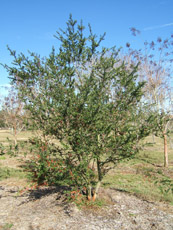Ilex vomitoria 'Dodds Cranberry' (Dodds Cranberry Yaupon Holly)
*Click on picture for more images of this species.
- USDA Hardiness Zone: 7A - 9B
- Mature Height: 15 to 30 ft
- Mature Spread: 12 to 20 ft
- Growth Rate: Moderate
- Availability: Generally available
- Drought Tolerance: High
- Salt Tolerance: High
- Light Requirements: Full sun to partial sun.
- Native Origin: Native to North America.
- Soil Drainage: Tolerates well-drained sites to sites with some flooding.
- Foliage: Evergreen tree with no showy fall color but very showy fruits.
- Flowers: White, not showy flowers in the spring.
- Pests: Free of serious pests and diseases, although scale, leaf miners, mites and aphids could become a problem.
Description: Yaupon Holly makes an upright, irregular, form with its upright crooked trunks and slender, curved, branches clothed with small, oval, grey-green foliage. Many nursery operators produce this tree with several trunks in a clump. Capable of reaching 30 feet or more in height, Yaupon Holly is most often seen 15 to 20 feet tall. Old plants will spread to 25 feet. The fruit puts on a spectacular display of the translucent red berries which attract wildlife. The flowers attract bees for several weeks.
The tree can be used as a screen planted about 8 to 10 feet apart in the full sun. As the tree grows older next to a sidewalk or patio, lower branches can be removed to allow for pedestrians to pass beneath. A sturdy North American native, Yaupon Holly is adaptable to a wide range of cultural conditions, from well-drained to wet, acid to alkaline, and sun to part-shade. It is very tolerant of drought and sea salt, and is one of the most durable and adaptable of the small-leaved evergreen Hollies for use in southern landscapes.
Gainesville Observations: Plants will require some training to produce a tree but this should be fairly easy when this begins in the nursery. Training to one trunk will make it much easier to use for street tree planting. Trees should be good candidates for planting near power lines. Our trees have put on abundant fruit but trees remain a bit thin, especially in dormant season. Multi-trunked trees will be difficult to use along streets because spreading and drooping branches block visibility.


